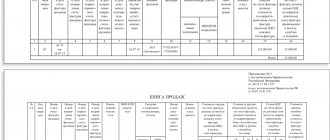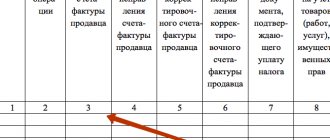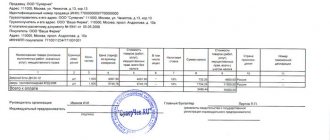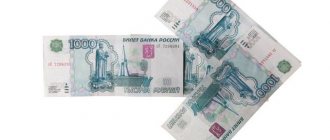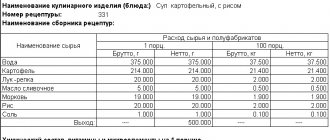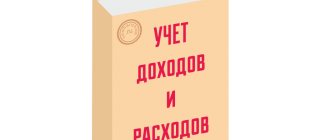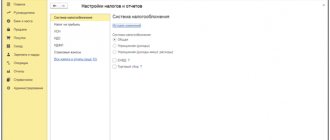Home / Taxes / What is VAT and when does it increase to 20 percent? / Book of purchases and sales
Back
Published: December 28, 2017
Reading time: 9 min
0
287
A tax document containing all the data on invoices on which VAT payers calculate tax for a certain quarter is called a purchase book.
- Shopping book - what is it?
- What information is required?
- What is not included in the document?
- What is reflected in the document?
- Purchase book according to resolution 1137
- Important Features
- Conclusion
What is a shopping book and what is it for?
A purchase ledger is a summary tax document.
It includes information about invoices on the basis of which VAT deductions are applied for the corresponding tax period (quarter). The purchase book is kept in the form of Appendix 4 to Decree of the Government of the Russian Federation dated December 26, 2011 No. 1137 (hereinafter referred to as Decree No. 1137). At the moment, the book form is used as amended by Decree of the Government of the Russian Federation dated August 19, 2017 No. 981. The April changes due to the increase in the VAT rate did not affect the purchase book.
Based on information from the purchase book, the amount of VAT deduction is reflected in the tax return. And the book’s indicators are included line by line directly in the VAT return. To do this, its form (approved by order of the Federal Tax Service of Russia dated October 29, 2014 No. ММВ-7-3 / [email protected] , as amended on December 28, 2018) provides for section 8. Such sections must be compiled as many as the number of entries registered in the purchase book for the corresponding quarter.
Maintaining a purchase book is the responsibility of VAT payers (clause 3 of Article 169 of the Tax Code of the Russian Federation). After all, only they have the right to deduction.
See also the materials “ Who is the VAT payer? " and " What are VAT tax deductions? " .
Based on the entries in the purchase book, accounting entries reflect the acceptance of VAT for deduction - through the entry Dt 68 Kt 19.
For details, see the material “ Posting “VAT accepted for deduction”: how to reflect it in accounting? " .
How to maintain an additional sheet for the purchase book
An additional sheet is drawn up if it is necessary to make adjustments to the purchase book at the end of the quarter due to the need to:
- cancel a document previously registered in the book;
- add to the previous quarter a document that was received late or with a correction.
This sheet has similar details and is an integral part of the source book, supplementing its information or correcting incorrectly reflected, erroneous data.
Filling out an additional sheet is similar to designing the book itself. First, the following data is transferred to the “total” page:
- If the first additional sheet is filled out, then information from the “total” page of the purchase book;
- If the second and subsequent sheets are filled out, then information from the “total” page of the previous additional sheet.
Next, column 16 of the sheet is filled in with information from the registered s/f. Depending on the reason for making the registration entry, there may be differences in filling out some fields:
- If a previously registered document is cancelled, then the data from columns 9 and 8, respectively, of the “total” s/f page are transferred to columns 15 and 16 with a “-” sign. The remaining columns are filled in as usual;
- If a late s/f is registered, then the details are entered in the columns of the table in the same way as when filling out the purchase book.
Next, the results are summed up on the “total” page, taking into account the values indicated on the “total” page – values with the “+” sign are added, and those with the “-” sign are subtracted. After completing the filling out of the additional sheet, it is certified by the signature of the manager and filed with the main ledger. If maintenance is carried out electronically, then the sheet is certified by the manager’s UKEP.
What goes into the shopping book
The purchase book records:
- Invoices, including:
- received from sellers (clause 2 of the rules for maintaining a purchase book, approved by Resolution 1137; hereinafter referred to as the Rules for maintaining a purchase book);
- advance invoices for the shipment of goods, works, services (GWS) (clause 22 of the Rules for maintaining the purchase ledger), see the material “ Acceptance for deduction of VAT on advances received ” ;
- adjustment invoices to reduce the cost of shipment from the seller and increase it from the buyer (clauses 9 and 12 of the Rules for maintaining the purchase ledger), see the material “ What is an adjustment invoice and when is it needed? " ;
- for construction and installation works for own consumption, when deducting VAT on them (clause 20 of the Rules for maintaining a purchase ledger).
- Other documents that, along with invoices, serve as the basis for deducting VAT, for example:
- strict reporting forms or copies thereof - when deducting travel expenses (clause 18 of the Rules for maintaining a purchase ledger);
- customs declaration and payment documents confirming payment of import VAT - upon import (clause 6 of the Rules for maintaining a purchase book);
- statements on the import of goods and payment of indirect taxes - when importing goods from the EAEU (clause 6 of the Rules for maintaining a purchase book), etc.
Entries in the purchase book are made as the right to tax deductions arises.
See the material “ What are VAT tax deductions? " .
In this case, invoices are registered in a unified manner (clause 2 of the Rules for maintaining a purchase ledger):
- regular, corrective and corrected;
- received on paper and electronically;
- filled out partly using a computer, partly by hand.
Registration of other documents
In addition to invoices, record in the purchase ledger:
- strict reporting forms (copies thereof) issued to employees when paying for rent and travel while on a business trip (clause 18, section II, appendix 4 to Decree of the Government of the Russian Federation of December 26, 2011 No. 1137);
- documents on the basis of which a shareholder (participant, shareholder) transfers property to the authorized capital of a commercial organization (if they contain the amount of tax recovered by the transferring party) (clause 14 of section II of Appendix 4 to the Decree of the Government of the Russian Federation of December 26, 2011 No. 1137 , subparagraph 1, paragraph 3, article 170 of the Tax Code of the Russian Federation);
- customs declarations (statements on the import of goods and payment of indirect taxes) when importing goods into Russia (subparagraphs “e” and “p”, paragraph 6 of section II of Appendix 4 to the Decree of the Government of the Russian Federation of December 26, 2011 No. 1137);
- payment orders confirming the payment of VAT when importing goods into Russia (subparagraph “k”, paragraph 6 of section II of Appendix 4 to the Decree of the Government of the Russian Federation of December 26, 2011 No. 1137);
- invoices registered in the sales book for goods (works, services) that are subject to VAT at a rate of 0 percent - if the documents confirming the right to apply the zero rate are not collected on time (clause 23.1 of section II of Appendix 4 to the Government Resolution RF dated December 26, 2011 No. 1137);
- invoices on the basis of which the submitted VAT was accepted for deduction and then restored in connection with the use of purchased goods (works, services, property rights) in transactions subject to VAT at a zero rate (clause 23.2 of Section II of Annex 4 to the Government Resolution RF dated December 26, 2011 No. 1137).
Situation: how to register an electronic ticket in the purchase book, in which the VAT amount is highlighted? The ticket was purchased through an intermediary who is not a VAT payer.
In your shopping book, record your printed itinerary/air ticket receipt or train ticket control coupon. There is no need to indicate information about the intermediary in the purchase book.
The current rules allow you to deduct VAT on travel expenses on the basis of a strict reporting form, if the amount of tax is allocated in it (clause 7 of Article 171, clause 1 of Article 172 of the Tax Code of the Russian Federation). The types of BSO confirming payment for travel are named in orders of the Ministry of Transport of Russia dated November 8, 2006 No. 134, dated August 21, 2012 No. 322. These are the following forms:
- route/receipt of an electronic passenger air ticket and baggage receipt (extract from the automated information system for registration of air transportation);
- control coupon of an electronic travel document (ticket) (extract from the automated control system for passenger transportation in railway transport).
On the basis of such documents, you can deduct the amount of VAT allocated in them (. 18 of Section II of Appendix 4 to the Procedure approved by Decree of the Government of the Russian Federation of December 26, 2011 No. 1137, letter of the Ministry of Finance of Russia dated January 30, 2015 No. 03-07- 11/3522, dated July 30, 2014 No. 03-07-11/37594, dated January 10, 2013 No. 03-07-11/01, dated January 12, 2011 No. 03-07-11/07).
You can take advantage of the deduction in the quarter in which the employee drew up an advance report for a business trip and indicated travel documents in it (letter of the Ministry of Finance of Russia dated May 20, 2008 No. 03-07-11/197).
When registering electronic tickets in the purchase book, consider the following feature. Transport agents sell tickets on behalf of the carrier or carrier's representative. For example, railway tickets for passenger transportation are sold by the carrier JSC FPC. Intermediaries distributing air and rail tickets cannot act on their own behalf. Therefore, the names and details of such intermediaries are not reflected in tickets. Therefore, there is no need to indicate information about them in the purchase book.
The detailed procedure for filling out the relevant columns of the purchase book is given in the table.
| Purchase ledger column | What to indicate |
| Box 1 | Record serial number |
| Column 2 | Transaction code 23 “Purchase of services issued with strict reporting forms in cases provided for in paragraph 7 of Article 171 of the Tax Code of the Russian Federation” (appendix to the letter of the Federal Tax Service of Russia dated January 22, 2015 No. GD-4-3/794) |
| Column 3 | Electronic ticket number (also the number of a strict reporting document) and the date of its issue |
| Columns 4–6 | Not filled in |
| Column 7 | Number and date of the document confirming payment for the ticket |
| Column 8 | Date of approval of the advance report |
| Column 9 | Carrier company name |
| Box 10 | Carrier INN (if available). This detail is not among the mandatory details approved by orders of the Ministry of Transport of Russia dated November 8, 2006 No. 134, dated August 21, 2012 No. 322. As a rule, electronic tickets for trains have a TIN, but electronic tickets do not. If the TIN is not specified, column 10 need not be filled in (letters of the Ministry of Finance of Russia dated May 28, 2015 No. 03-07-11/30876, Federal Tax Service of Russia dated August 18, 2015 No. GD-4-3/14544) |
| Columns 11–12 | Not filled in |
| Box 13 | Not filled in |
| Box 14 | Currency code if the fare on the ticket is expressed in a foreign currency. If the fare on the ticket is indicated in rubles, do not fill out the column |
| Box 15 | Fare (including VAT). If the fare on the ticket is indicated in foreign currency, the indicator in column 15 is also indicated in foreign currency |
| Box 16 | The amount of VAT allocated on the ticket |
Example of registration in the e-ticket purchase book
Two employees of the organization were sent on business trips. A.S. Kondratiev - in Saratov, V.N. Volkov - in Yekaterinburg.
At the end of their business trips, employees submitted advance reports:
– A.S. Kondratiev - April 21. He attached to the advance report a control coupon for electronic ticket No. GP7655318 985322 dated 04/17/2016 in the amount of 5,600 rubles. (including VAT – 854.24 rubles). The ticket was purchased and paid for through the transport agent’s website. The ticket seller is JSC FPC;
– V.N. Volkov - April 23. He attached to the advance report the route/receipt for electronic passenger air ticket No. 262 24017991410 dated 04/18/2016 in the amount of 17,500 rubles. (including VAT - 2669.49 rubles). The ticket was purchased and paid for at the ticket office of the transport agent. The ticket seller is Ural Airlines JSC.
The accountant recorded these documents in the purchase book.
Situation: what documents confirming the transfer of fixed assets to the authorized capital must be registered in the purchase book of the receiving party (commercial organization)?
Tax legislation does not establish a list of such documents. In paragraph 15 of Appendix 3 to the Decree of the Government of the Russian Federation of December 26, 2011 No. 1137 it only says that these documents:
- must contain information about the amount of VAT recovered by the transferring party;
- are registered in the purchase book of the receiving party as its right to deduct VAT arises.
The financial department also does not specify the composition of these documents (letter of the Ministry of Finance of Russia dated November 21, 2011 No. 03-07-11/317).
In practice, the amount of VAT that is recovered by the founder (shareholder, participant) when transferring a fixed asset to the authorized capital of a subsidiary can be reflected in the acceptance and transfer certificates using forms No. OS-1 (No. OS-1a, No. OS-1b). If such data is available, the receiving party registers these acts or their notarized copies in the purchase book. The right to deduct VAT recovered by the transferring party arises when the received fixed assets are placed on the balance sheet (if the fixed assets will be used in activities subject to VAT).
Situation: what documents need to be registered in the purchase book when paying the buyer money for returned goods? The buyer returned an item previously purchased at retail.
The answer to this question depends on two factors:
- when the buyer returned the goods;
- how the goods were paid for.
In practice, the following situations are possible:
- the goods were returned on the day of purchase and the goods were paid for in cash;
- the goods were returned on the day of purchase, and the goods were paid for using a bank card;
- the return occurred later than the day of purchase, and the goods were paid for in cash;
- the return occurred later than the day of purchase, and the goods were paid for using a bank card.
If the buyer returned the product on the day of its purchase, then operations to return it are not reflected in the purchase book, regardless of the payment method (cash or bank card). It is explained this way.
As a general rule, VAT previously charged to the buyer on returned goods can be deducted by the seller. Moreover, if the buyer is not a VAT payer, the seller has the right to deduction if the following conditions are met:
- the returned goods are registered;
- an adjustment invoice compiled by the seller based on the primary invoice is registered in the purchase book;
- no more than a year has passed since the goods were returned.
This procedure follows from the provisions of paragraph 5 of Article 171, paragraphs 1 and 4 of Article 172, paragraph 1 of Article 169 of the Tax Code of the Russian Federation.
However, in this situation, since the returned item was sold at retail, these rules do not apply. When selling goods at retail, the seller does not issue invoices to customers, and in the sales book he registers either data from CCP control tapes (Z-reports) or strict reporting forms (clause 1 of Section II of Appendix 5 to the Decree of the Government of the Russian Federation of December 26, 2011 No. 1137).
If the product is returned on the day it was purchased, then the amount of revenue for that day is reflected in the accounting and sales book minus the cost of the returned product. Accordingly, the amount of VAT charged to the buyer who returned the goods is not charged to the budget and is not recorded in the sales book. This procedure follows from sections 4 and 6 of the Model Rules approved by the Ministry of Finance of Russia on August 30, 1993 No. 104, instructions approved by Resolution of the State Statistics Committee of Russia dated December 25, 1998 No. 132, paragraph 1 of Section II of Appendix 5 to the Resolution of the Government of the Russian Federation of December 26 2011 No. 1137. This procedure applies regardless of how the goods were paid for: in cash or by bank card. Thus, when returning the goods on the day of purchase, there is no amount of VAT that could be deducted (the tax was not initially charged). This means that there is no need to adjust VAT or make any entries in the purchase book.
If the buyer pays for the goods in cash and returns it later than the day of purchase, then the money is given to him from the organization’s cash register on the basis of a cash receipt order (form KO-2) (clause 4.4 of the Methodological Recommendations approved by Roskomtorg letter dated July 10, 1996 No. 1-794 /32-5, clause 6 of Bank of Russia Directive No. 3210-U dated March 11, 2014). To justify the deduction in the purchase book, register the details of this document (transaction type code 17). VAT on returned goods can be deducted if other mandatory conditions are met. The legitimacy of this approach is confirmed by letter of the Ministry of Finance of Russia dated March 19, 2013 No. 03-07-15/8473.
If the buyer paid for the goods with a bank card and returns it later than the day of purchase, then a cash receipt order (form KO-2) is not issued to him. This is due to the fact that it is not possible to issue cash for goods previously paid for by card (clause 2 of Bank of Russia instructions dated October 7, 2013 No. 3073-U). Money for returned goods, previously paid for by card, is transferred to the buyer’s bank account. At the same time, the operation “Return of sale” is performed on the cash register, during which a return receipt is issued (clauses 3.6 and 4.8 of Appendix 5 to the minutes of the GMEC meeting dated December 19, 2002 No. 7/72-2002). By analogy with the procedure established for processing a cash refund, you can register the details of this receipt in the purchase book.
However, this approach may lead to disagreements with inspectors. The fact is that the procedure for documenting deductions when returning goods sold at retail and paid for with bank cards is not regulated by law. There are also no official explanations from regulatory agencies on this issue. Therefore, to avoid disputes, when returning goods, please prepare a corrective invoice and record it in your purchase ledger. And since an adjustment invoice can only be issued to an existing initial invoice, it is advisable for a retail organization that accepts bank cards for payment to prepare general invoices on a daily basis indicating the total revenue for goods sold at retail. The basis for such invoices can be Z-reports, which record total revenue broken down into cash receipts and receipts from bank cards.
What doesn't make it into the shopping book?
Invoices that do not comply (clause 3 of the Rules for maintaining a purchase ledger) should not be included in the purchase ledger:
- requirements of Art. 169 of the Tax Code of the Russian Federation ( see the material “ What errors in filling out an invoice are not critical for deducting VAT?” );
- established forms (Appendices 1 and 2 to Resolution No. 1137).
In addition, the book does not record invoices received (clause 19 of the Rules for maintaining a purchase ledger):
- upon gratuitous transfer of industrial and technical materials, including fixed assets and intangible assets;
- commission agent (agent) from the principal (principal) for goods and services transferred for sale, property rights, as well as advances received for this sale;
- commission agent (agent) from the seller of goods and services or property rights acquired for the principal (principal), including for advances issued;
- for the amount of prepayment for goods and materials purchased for VAT-free transactions;
- advance invoices issued or received after the seller has received (issued) shipping invoices.
Please note that from clause 19 of the Rules for maintaining a purchase book in its latest edition, subparagraph “e” was excluded, which read as follows: “e) for the amount of payment, partial payment for upcoming deliveries of goods (performance of work, provision of services), transfer property rights in non-monetary forms of payment."
Thus, now a “non-cash” advance is not an obstacle to reflecting an advance invoice in the purchase book and, as a result, does not interfere with VAT deduction.
Sales to a legal entity or individual entrepreneur
The simplest case is that a product, work or service is sold by a VAT payer to a company or entrepreneur who also pays this tax. In this case, the supplier reflects the transaction in its sales book, and the buyer - in the purchase book, with the code 01.
The remaining transactions must be reflected as follows:
- sales by a tax agent - in the sales book with code 06;
- purchase by a tax agent - in the purchase book with a code 06;
- transfer of property rights - in the sales book with code 14;
- transaction for capital construction and modernization of real estate - in the contractor’s sales book and in the customer’s purchase book with a code 13;
- free transfer of property - in the sales book with a code 10.
As for transactions that were carried out with the participation of an intermediary, we described them in detail in the article How to reflect intermediary transactions in documents used in VAT calculations.
In cases where goods are sold to a counterparty who does not pay VAT, an invoice may not be issued. To do this, a written agreement must be concluded between the parties. The seller creates a consolidated invoice for the quarter or month, which collects all transactions to that buyer. The consolidated invoice is reflected in the sales book with the code 26.
If the buyer decides to return the goods or refuse to accept them, he must issue an invoice. This document must be registered with code 01 in the buyer’s sales book, and with the same code in the seller’s purchase book. This is true when both counterparties are VAT payers.
What if the goods are returned by a buyer who does not pay VAT?
Of course, in this case he does not issue an invoice. The seller needs to re-register the invoice previously issued to this buyer, only now in his purchase book with code 16 . It turns out that in this situation the seller will reflect the same invoice twice: in the sales book with code 01 or 26 - when shipping the goods to the buyer, and in the purchase book with code 16 - when receiving it back.
Example 1
The seller on OSN sold goods to a simplified buyer in the amount of 118 thousand rubles, of which VAT amounted to 18 thousand rubles. He reflected this operation with the following entry in his sales book:
| Column number | 2 | 7 | 13b | 14 | 17 |
| Meaning | 01 | buyer's name | 118 000 | 100 000 | 18 000 |
However, subsequently the buyer returned to the seller part of the goods in the amount of 29.5 thousand rubles, including VAT - 4.5 thousand rubles. In this case, the seller re-reflects the previously issued invoice, but in the purchase book:
| Column number | 2 | 9 | 15 | 16 |
| Meaning | 16 | seller's name | 29 500 | 4 500 |
What is reflected in the purchase book
The purchase book reflects the following information:
- in the header - information about the taxpayer-buyer (its full or abbreviated name in accordance with the constituent documents (or full name of the individual entrepreneur), INN and KPP), as well as information about the tax period (its start and end dates);
- in the tabular part - information about the documents serving as the basis for deducting VAT and its amount.
NOTE! If goods and services are purchased for transactions taxed at rates of 20, 10 and 0%, the invoice must be registered in the purchase book in parts - on the dates when the right to deduction arises (clause 6 of the Rules for maintaining the purchase book, letter from the Ministry of Finance of Russia dated March 17. 2015 No. 03-07-11/14238 and 03/02/2015 No. 03-07-09/10695).
See the material “ How to apply VAT deduction on export transactions ” .
If the purchase is intended for taxable and non-taxable transactions, an invoice is registered for the amount accepted for deduction based on the proportion of separate accounting (clause 6 of the Rules for maintaining the purchase ledger).
Purchase book according to resolution 1137
According to Resolution 1137, the purchase book is filled out in the following order (clause 6 of the Rules for maintaining the purchase book):
- Column 1 indicates the serial number of the record of information about the invoice (including adjustment);
- in column 2 the code of the type of operation is entered (see order of the Federal Tax Service of Russia dated March 14, 2016 No. ММВ-7-3/ [email protected] );
- Column 3 generally reflects the serial number and date of the seller’s invoice; if the deduction is confirmed by other documents, then their details are provided (for example, a customs declaration, an application for import, etc.);
The latest edition of Resolution No. 1137 clarifies that in column 3 you need to indicate:
| Data to fill out column 3 | Under what conditions |
| No. and date of the application for the import of goods and payment of indirect taxes with marks from the tax authorities regarding the payment of VAT | When importing goods into the Russian Federation from EAEU countries |
| Registration number of the customs declaration issued upon release of goods in accordance with the customs procedure for release for domestic consumption upon completion of the customs procedure of the free customs zone on the territory of the SEZ in the Kaliningrad region | When reflecting VAT in the purchase book, which is accepted for deduction on the basis of clause 14 of Art. 171 Tax Code of the Russian Federation |
| No. and date of the payment and settlement document or other document containing summary (summary) data registered by the seller in the sales book | When reflecting VAT on an advance (prepayment) received on account of upcoming supplies of goods and materials and subject to deduction from the date of shipment of goods and materials |
- in columns 4–6 - serial numbers and dates of corrected, corrective or amended adjustment invoices;
- in column 7 - the number and date of the document confirming payment of the tax (you must reflect the details of the payment document in column 7 of the purchase book if VAT is deducted only after it is paid: for example, when importing goods into the Russian Federation (see letter from the Ministry of Finance Russia dated November 26, 2014 No. 03-07-11/60221) or return of the advance payment to the buyer in case of termination/change of the contract, letters of the Ministry of Finance of Russia dated March 24, 2015 No. 03-07-11/16044 and March 23, 2015 No. 03-07-11 /15889);
- in column 8 - the date of registration of goods (performance of work, provision of services), property rights;
- in columns 9 and 10 - the name and INN/KPP of the seller, respectively;
- columns 11 and 12 are filled in by the buyer-committee (principal) - they indicate the name, tax identification number and checkpoint of the intermediary commission agent (agent) purchasing the goods and services on his own behalf;
- in column 13 indicate the registration number of the customs declaration when selling goods imported into the Russian Federation, if their customs declaration is provided for by the customs legislation of the Customs Union; the column is not filled in when reflecting data on an adjustment (corrected adjustment) invoice in the purchase book;
- in column 14 - the name and code of the currency (only in the case of purchasing goods and services, property rights for foreign currency);
- in column 15 - the cost of goods and services, property rights or the amount of the advance payment including VAT;
- in column 16 - the amount of VAT accepted for deduction.
Registration of invoices
In the purchase book, record invoices received from sellers (executors), as well as from tax agents. The following invoices are subject to registration:
- exhibited by sellers (executors, tax agents specified in paragraphs 4 and 5 of Article 161 of the Tax Code of the Russian Federation) when selling goods (performing work, providing services, transferring property rights);
- issued by sellers (executors, tax agents specified in paragraphs 4 and 5 of Article 161 of the Tax Code of the Russian Federation) upon receipt of advances (partial payment) from the buyer (customer);
- compiled by tax agents specified in paragraphs 2, 3 of Article 161 of the Tax Code of the Russian Federation when presenting VAT for deduction.
In addition, the following must be registered in the purchase book:
- “positive” adjustment invoices from buyers in the event of an increase in the cost of goods received (work performed, services provided), property rights;
- “negative” adjustment invoices from sellers in the event of a decrease in the cost of goods shipped (work performed, services rendered) or transferred property rights.
Do not register invoices that are filled out in violation of Article 169 of the Tax Code of the Russian Federation or do not correspond to the forms approved by Decree of the Government of the Russian Federation of December 26, 2011 No. 1137.
This procedure is provided for in paragraphs 1, 3,16, 20, 21, 23 of Section II of Appendix 4 to Decree of the Government of the Russian Federation of December 26, 2011 No. 1137.
As a general rule, invoices received from sellers are recorded in the purchase ledger as they become eligible for tax deductions. This is stated in paragraph 1 of paragraph 2 of section II of Appendix 4 to the Decree of the Government of the Russian Federation of December 26, 2011 No. 1137. Moreover, in some cases, an invoice needs to be registered only when the goods (work, services, property rights) are not only accepted accounted for, but also paid. This situation may arise, for example, if an organization acts as a tax agent in transactions with foreign organizations. In this case, the buyer has the right to register an invoice in the purchase book only after transferring payment to the foreign organization and VAT amounts to the budget. This procedure follows from paragraph 3 of Article 171 of the Tax Code of the Russian Federation and paragraph 23 of Section II of Annex 4 to the Decree of the Government of the Russian Federation of December 26, 2011 No. 1137. If the registered goods (work, services, property rights) were partially paid, the invoice Register an invoice for each amount paid (in this case, registration of invoices with the same details is allowed). Next to the paid amount in column 3 of the purchase book, write the following: “Partial payment.” This procedure is provided for in paragraph 16 of Section II of Appendix 4 to the Decree of the Government of the Russian Federation of December 26, 2011 No. 1137.
In practice, it happens that the buyer receives an invoice for goods (work, services) accepted for accounting during a quarter from the seller only in the next quarter. In what tax period does the buyer have the right to a tax deduction?
The answer to this question depends on whether the invoice was received before or after the due date for filing the return for the past quarter. If the invoice is received by the buyer before the 25th day of the month following the reporting quarter, it can be recorded in the purchase ledger retroactively. Accordingly, the right to deduct VAT on this invoice will appear in the past quarter. If the invoice arrived later, it must be registered in the purchase book in the next quarter.
This procedure is provided for in paragraph 1.1 of Article 172 of the Tax Code of the Russian Federation.
An example of recording invoices received by the buyer at the end of the quarter in the purchase book
At the end of March, Alpha LLC accepted for accounting: – a batch of goods for resale worth RUB 236,000. (including VAT – RUB 36,000); – utilities for the first quarter costing RUB 590,000. (including VAT – 90,000 rubles).
Invoices from suppliers were received by the organization in the second quarter:
– for goods – April 20; – for utilities – April 28.
Guided by the provisions of paragraph 1.1 of Article 172 of the Tax Code of the Russian Federation, the Alpha accountant registered:
– in the purchase book for the first quarter – an invoice for goods; – in the purchase book for the second quarter – an invoice for utilities.
Alpha submitted its VAT return for the first quarter to the tax office on April 27 (April 25 and 26 are days off). The declaration reflects the deduction of VAT on goods capitalized in the first quarter - 36,000 rubles.
The amount of VAT on utilities (90,000 rubles) was presented for deduction in the declaration for the second quarter.
Situation: is it necessary to register invoices with a zero VAT rate in the purchase ledger?
Yes need.
In the purchase book, it is mandatory to register all invoices received from the seller, both for advances and for shipment (clauses 20, 21 of section II of Appendix 4 to Decree of the Government of the Russian Federation of December 26, 2011 No. 1137). And the seller issues invoices for all transactions, which are subject to VAT at a rate of 0%. Including at a 0 percent rate, for example, when exporting.
There are exceptions when it is not necessary to register invoices in the purchase book (clause 19 of section II of appendix 4 to the Decree of the Government of the Russian Federation of December 26, 2011 No. 1137). But the zero rate case is not one of them.
When you register an invoice with a rate of 0 percent in the purchase book, enter zero in column 16 “VAT amount on invoice” (subparagraph “y”, paragraph 6 of section II of Appendix 4 to the Decree of the Government of the Russian Federation of December 26, 2011 No. 1137).
At the same time, an organization should not be alarmed if it has not included separate invoices, including those with a zero tax rate, in the purchase book. Most courts believe that violation of the procedure for maintaining a purchase ledger is not grounds for refusal to deduct (resolution of the Federal Antimonopoly Service of the Moscow District dated January 17, 2013 No. A40-40046/2012, Volga District dated February 12, 2013 No. A65-14995/2012, Ural District dated April 18, 2013 No. F09-3460/13). In this case, the organization has no right to deduction at all, since the amount of VAT is zero. In addition, neither the Tax Code of the Russian Federation nor the Code of Administrative Offenses of the Russian Federation provides for liability for incorrect maintenance of the purchase book.
Situation: in which tax period should invoices issued by suppliers when shipping goods be registered in the purchase ledger? The organization sells goods for export.
Invoices received from suppliers are registered in the purchase book as the right to tax deductions arises (paragraph 1, clause 2, section II, appendix 4 to Decree of the Government of the Russian Federation of December 26, 2011 No. 1137). VAT on export transactions is deductible in a special manner. This can be done subject to the submission of documents confirming the legality of applying the VAT rate of 0 percent (clause 3 of Article 172 of the Tax Code of the Russian Federation). Thus, register supplier invoices for goods that were subsequently sold for export in the purchase book in the quarter when the full package of supporting documents was collected. Similar explanations are contained in the letter of the Federal Tax Service of Russia dated August 9, 2006 No. ШТ-6-03/786.
Procedure for filling out the purchase book
Basic rules for working with a purchase book:
- fill out the purchase book in a way convenient for you - on paper or electronically;
- indicate cost indicators in rubles and kopecks (with the exception of column 15, filled in when purchasing goods and services or property rights for foreign currency);
- to correct incorrect entries in the purchase ledger, register or cancel the corrected invoice in the additional list of the purchase ledger in the same quarter when the first invoice was received;
- at the end of each quarter (no later than the 25th day of the month following the end of the quarter), sign the paper version of the purchase book from the manager (or an authorized person), lace and number the pages, seal them (if any);
- Keep sales books for at least 4 years from the date of last entry.
Find out what to consider when filling out an invoice from the materials in this section of our website.
Results
So, we found out that:
- the purchase book is maintained by VAT payers in order to determine the amount of tax deduction;
- the form and rules for maintaining a purchase book are strictly regulated by Decree of the Government of the Russian Federation dated December 26, 2011 No. 1137;
- information from the purchase book forms the VAT return indicators and is directly included in it;
- Based on entries in the purchase book, VAT deduction is reflected in accounting.
You can find more complete information on the topic in ConsultantPlus. Free trial access to the system for 2 days.
Deciding on the start date for use: no need to rush
The commented Resolution was published on 08/06/2014. There is no specific indication of the effective date. Therefore, if we focus on the procedure for the entry into force of government regulations, it should begin to take effect 7 days after the day of publication (that is, 08/14/2014) (Clause 6 of Decree of the President of the Russian Federation dated 05/23/1996 N 763).
But tax service specialists believe that general rules governing the procedure for the entry into force of tax regulations should be applied (Clause 1, 5, Article 5 of the Tax Code of the Russian Federation).
From authoritative sources. Duminskaya Olga Sergeevna, Advisor to the State Civil Service of the Russian Federation, 2nd class “Resolution of the Government of the Russian Federation of July 30, 2014 N 735, which introduced changes to the forms of the invoice journal, purchase books and sales books, as well as other changes to the Decree of the Government of the Russian Federation of December 26, 2011 N 1137, in accordance with paragraphs 1 and 5 of Art. 5 of the Tax Code of the Russian Federation, comes into force from the new tax period, that is, from October 1, 2014.”
Note. By the way, a similar question arose after the publication of Resolution No. 1137 itself, which approved the forms of VAT documents, which are now being amended. If you remember, it was published in January 2012 and there was no special explanation about the effective date. And the Ministry of Finance explained that the old forms of invoices, accounting journal, purchase and sales books can be used until the end of the quarter, that is, until April 1, 2012 (Letter of the Ministry of Finance of Russia dated January 31, 2012 N 03-07-15/11).
